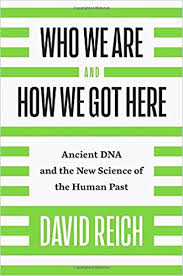 One of the more interesting and definite aspects of David Reich’s Who We Are and How We Got Here is on caste. In short, it looks like most Indian jatis have been genetically endogamous for ~2,000 years, and, varna groups exhibit some consistent genetic differences.
One of the more interesting and definite aspects of David Reich’s Who We Are and How We Got Here is on caste. In short, it looks like most Indian jatis have been genetically endogamous for ~2,000 years, and, varna groups exhibit some consistent genetic differences.
This is relevant because it makes the social constructionist view rather untenable. The genetic distinctiveness of jati groups is very hard to deny, it jumps out of the data. The assertions about varna are fuzzier. But, on the whole Brahmins across South Asia have the most ancestry from ancient “steppe” groups, while Dalits across South Asia have the least. Kshatriya is closer to Brahmins. Vaisya has lower fractions of “steppe”. And so on. These varna generalizations aren’t as clear and distinct as jati endogamy. Sudras from Punjab may have as much or more “steppe” than South Indian Brahmins. But the coarse patterns are striking.
As a geneticist, and as an irreligious atheist, a lot of the conversations about “caste” are irrelevant to me. They’re semantical.
You can tell me that true Hinduism doesn’t have caste, that it was “invented” by Westerners. They may not have had caste, but the genetical data is clear that South Asians were endogamous for 2,000 years to an extreme degree. Additionally, the classical caste hierarchy seems to correlate with particular ancestry fractions.
Second, you can say Islam, Sikhism, Jainism, and Buddhism don’t have caste. That they picked it up from Hinduism. Or Indian culture. That’s true. But I think Islam, Sikhism, Jainism, and Buddhism are all made up, just like Hinduism. I don’t care if made up ideologies don’t have caste in their made up religious system. I am curious about the revealed patterns genetically.
I have a pretty big data set of South Asians. Some of them are from the 1000 Genomes. Here is where the 1000 Genomes South Asians were collected:
Gujarati Indians from Houston, Texas
Punjabi from Lahore, Pakistan
Bengali from Dhaka, Bangladesh
Sri Lankan Tamil from the UK
Indian Telugu from the UK
Some of the groups showed a lot of genetic variation, so I split them based on how much “Ancestral North Indian” (ANI) they had. So Gujurati_ANI_1 has more ANI than Gujurati_ANI_2 and so forth.
Here is a tree showing pairwise genetic distances between the groups:
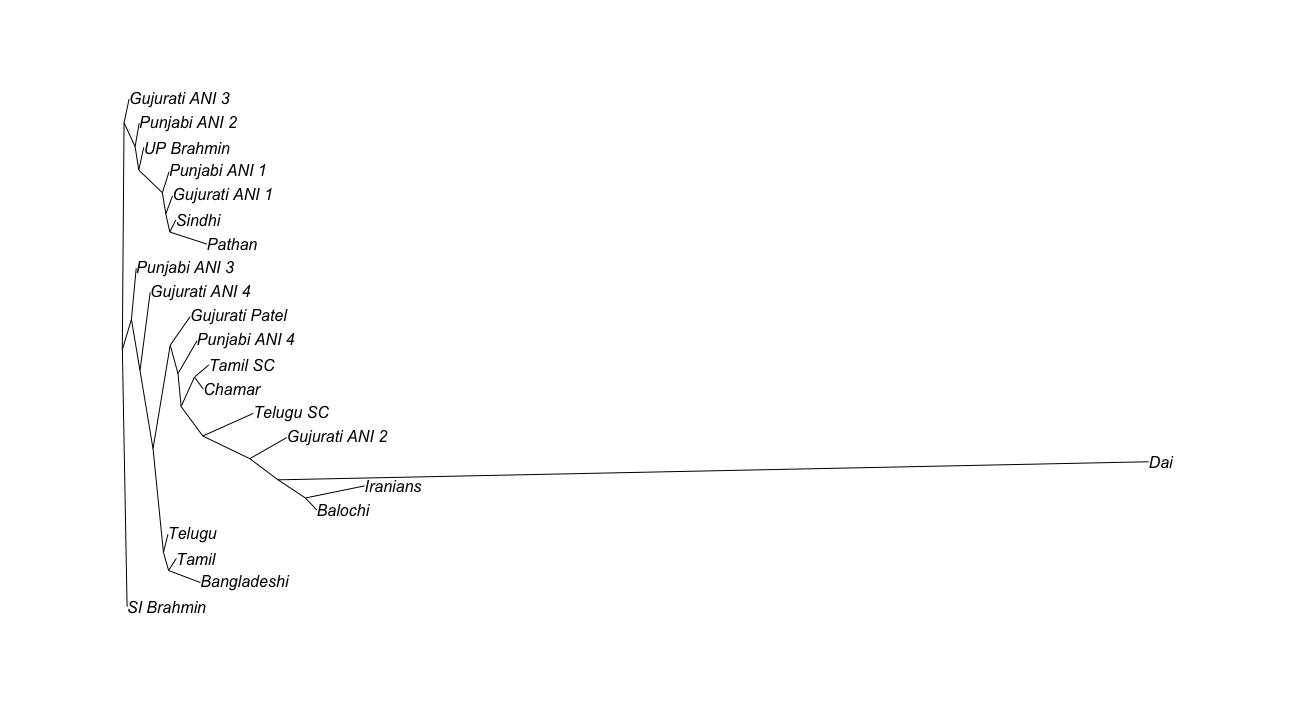
The positioning of some groups near each other is an artifact. Dai from China is an outgroup, as are Iranians and Baloch. So all are pushed near each other.
Treemix with 3 migrations shows similar patterns:
Now let’s do a PCA:
Click the link above and you’ll see Bangladeshis are all shifted toward Dai. The Iranians are at the bottom, but nearest to them are the Baloch. Then the Pathan. Then Punjabi_ANI_1.
Let’s zoom in on the South Asian groups.
Do you notice something about the Bangladeshis? They don’t have much South Asian ancestry variation. Their variation is all due to East Asian ancestry, which seems to have a west to east gradient (I’m way on the right edge, and my family is from the eastern edge of eastern Bengali).
This is not the case for Punjabis.
As you can see, the Punjabis sampled in Lahore range form almost Pathan to almost South Indian. This totally shocked me. This is a huge range of variation.
Compare to Gujus:
I’m pretty sure there are only a few Gujurati_ANI_4 because the sampling occurred in Houston, TX (Indian gov. stingy about genetic testing/sampling, so usually done in Diaspora). Notice that Gujus, mostly Hindu, have the same genetic variation as Punjabis!
Now let’s compare Dalits to Brahmins.
To my surprise, Chamars from UP are quite like South Indian Dalits (there is some “steppe” admixture you can detect in Chamars, so they’re not identical). South Indian Brahmins have some local admixture.
What’s my point here?
In some of the comments, there was talk about how Bengali Muslims have their own form of caste. This seems plausible, though I wouldn’t know personally. I wasn’t raised in Bangladesh. But these data make it clear that there’s almost no caste-like structure in Bangladesh genetically. The variation is almost all due to the mixture with East Asian-like people, and that’s almost certainly due to geography (West Bengalis have this, but to a lesser portion, and people from eastern Bangladesh have more than people from western Bangladesh).
In contrast, when you look at the 1000 Genomes Telugu or Tamil sample structure jumps out. First, there are a small number of Brahmins. But there is also a large group which is clearly scheduled caste. Looking at Gujuratis, they are very diverse. The Patels probably anchor the Sudra/ middle-class component dominant in the region.
Punjab looks like the Indian groups, not Bangladesh. I have no idea about Pakistani caste or class dynamics, but the genetics makes it look like the social structure of Hindus. In contrast, Bangladesh looks like a non-South Asian population, with most of the variation being due to geography and proximity to a very different group (Tibeto-Burmans).
I don’t think Bengalis are more punctilious Muslims than Punjabis. I think the social landscape of Bengal emerged out of a frontier expansion which destablized the default Indian caste structures that undergired most societies. In Pakistan Islamicization didn’t perturb the underlying Indianness of Punjabis.
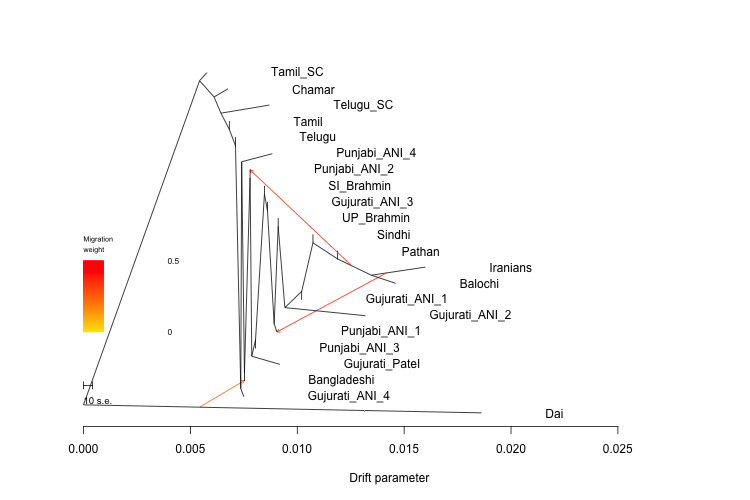
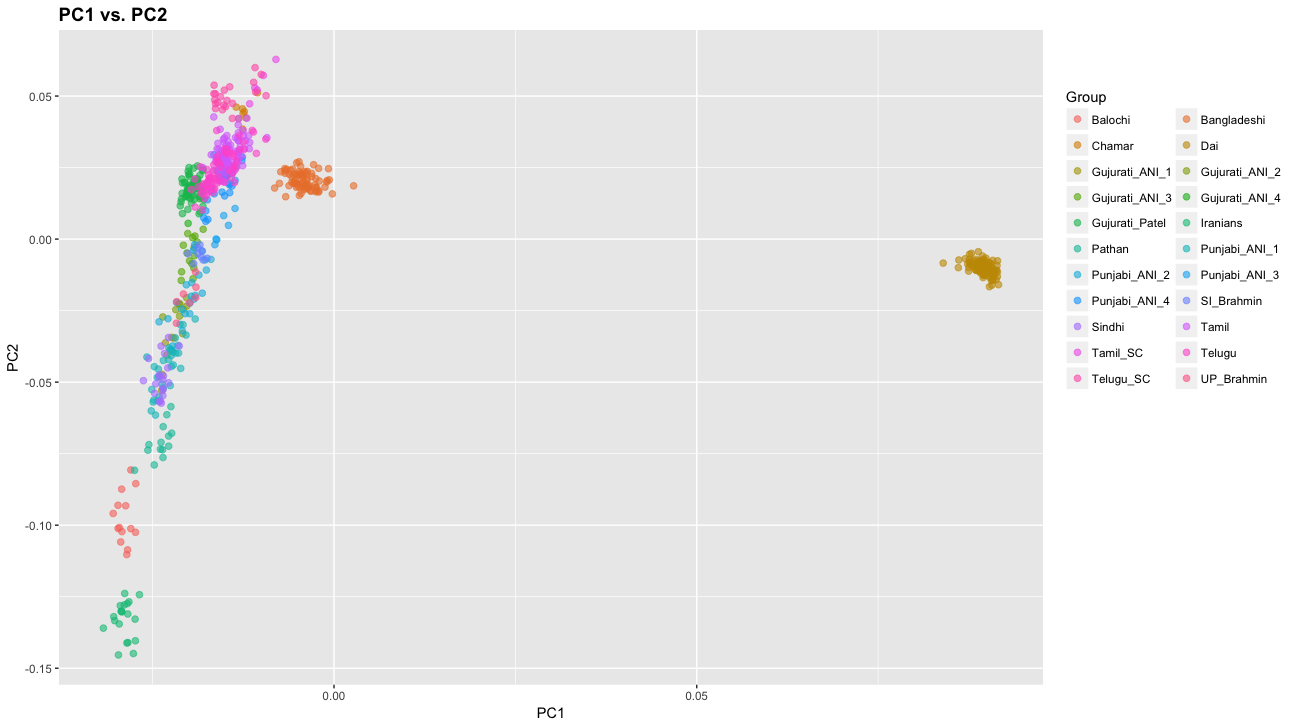
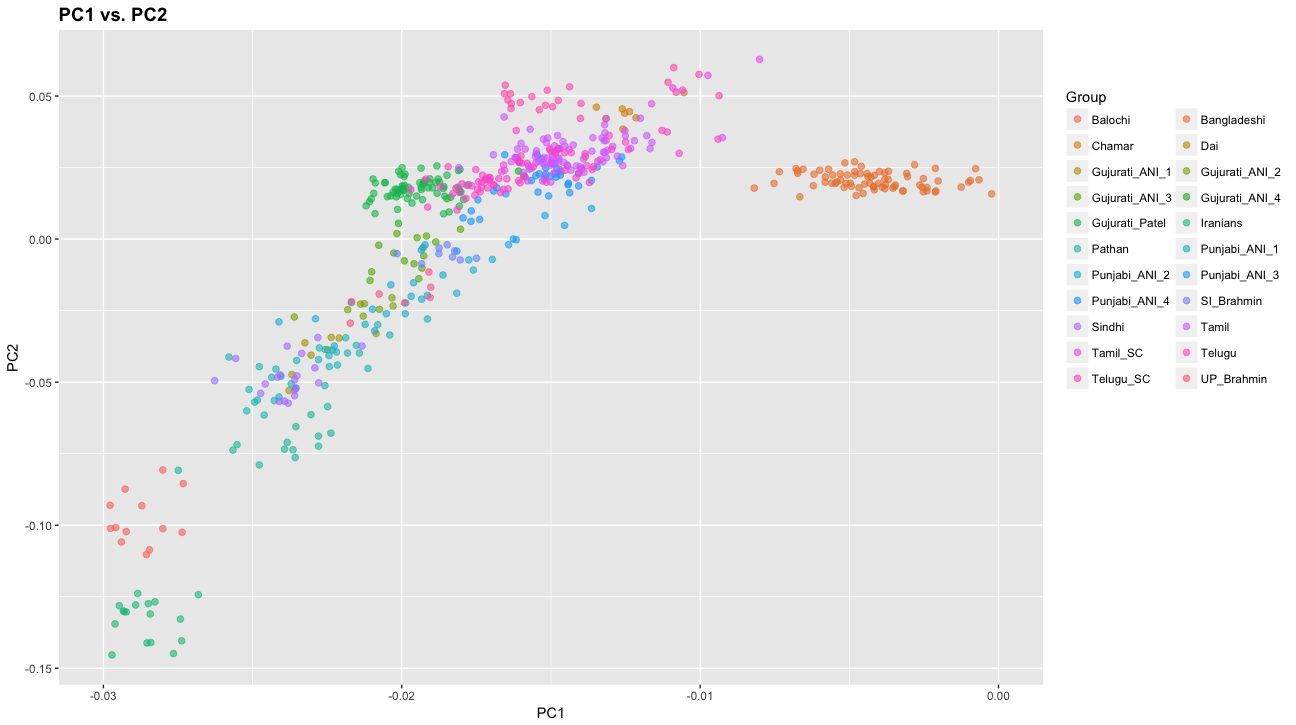
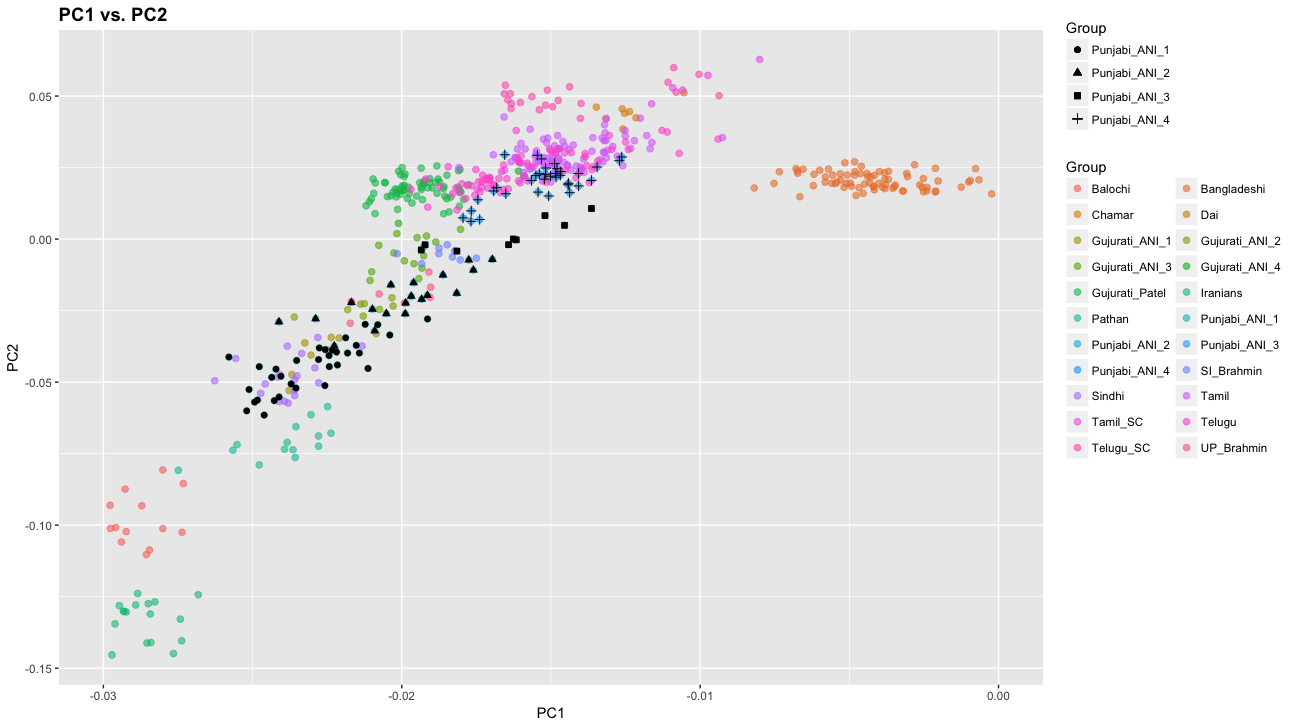
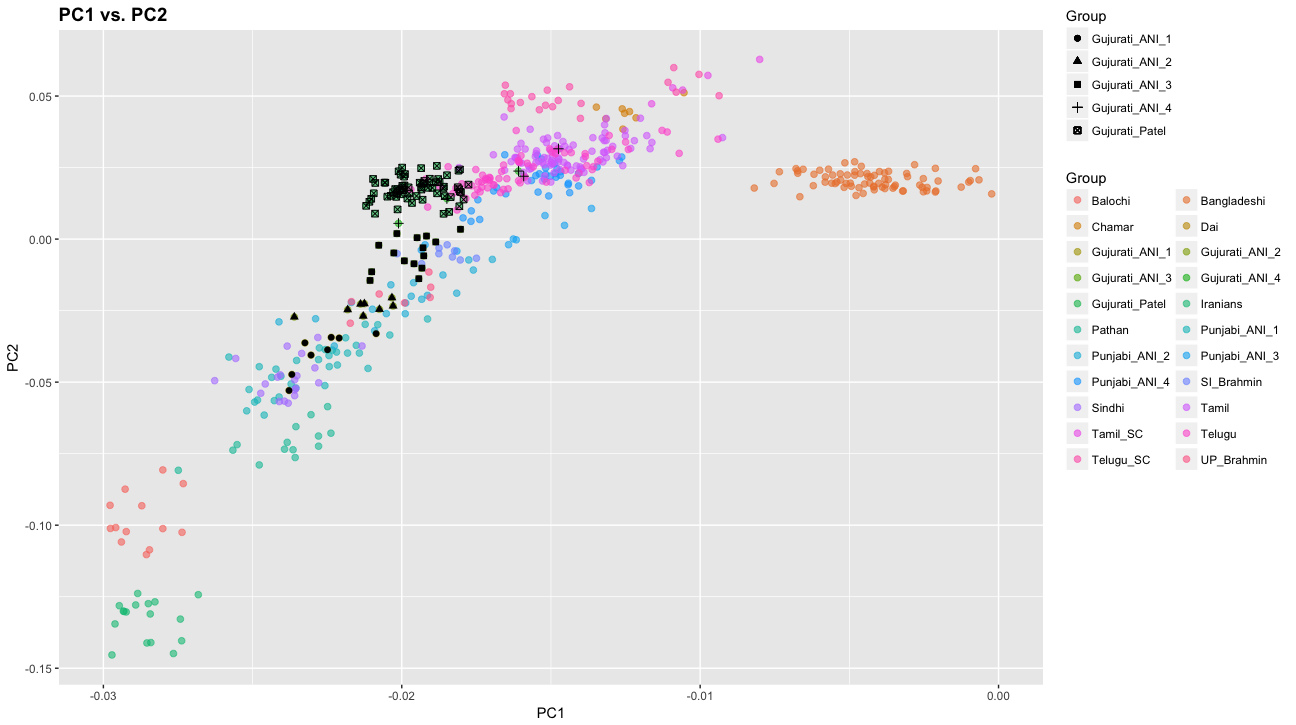
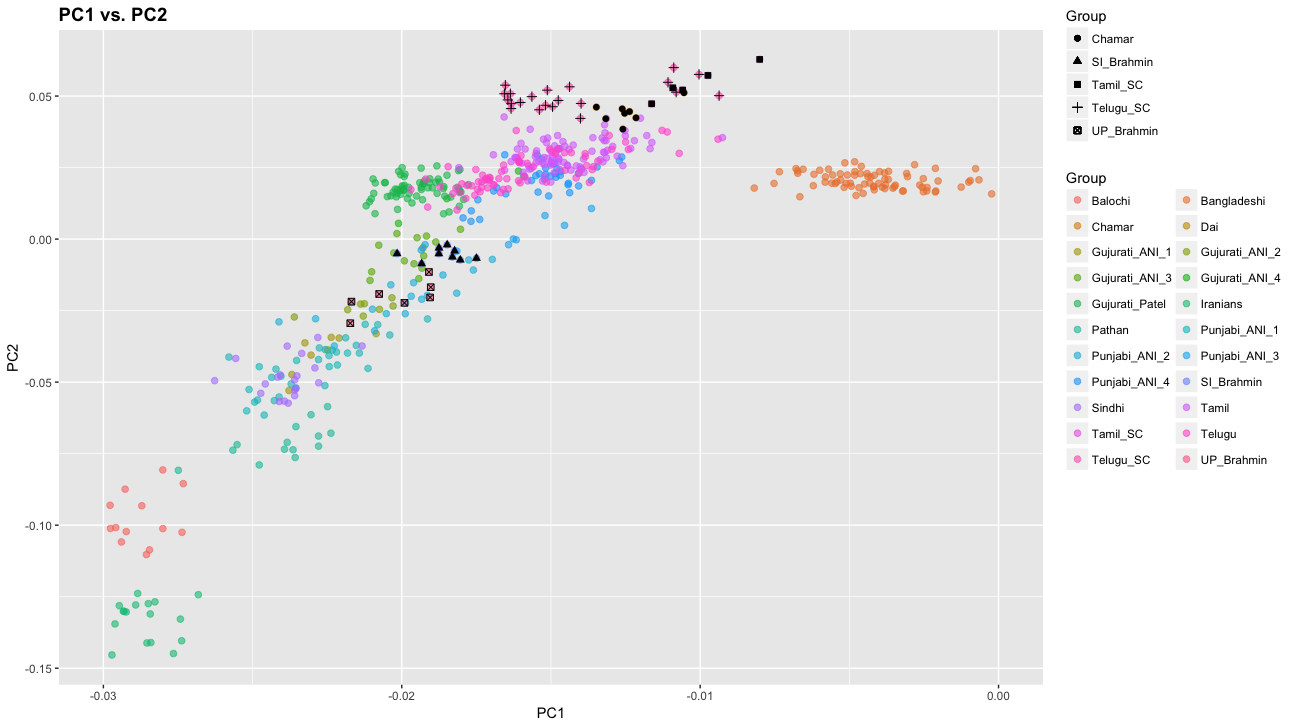
Very good article Razib. It will take me some time to fully digest. I learn a ton from all your articles. You are absolutely correct about the correlation between Jati and genetics and how it explains much about the world. I like the way you emphasize the phrase “Jati” rather than caste. Jati is deeply embedded in human civilizations and history around the world including all the Arya influenced ones.
Personally I love Sayyidas and Sayyids. But all they are is Jati.
Razib
Do you have enough data on Sri Lankan as a group and as seperated by Tamil and Sinhalese.
I would love to learn about sinhalese genetics! C’mon Razib!
i don’t have any sinhalese. trying to get some.
these are tamils.
Generally Indologists also talk about introduction of horse along with steppe ancestry, both horse riding and chariots pulled by horse . Chriots involve more technologies and we will ignore that for a moment .If horse-philia is so characteristic of steppe people, and the genetic variations preserved due to caste structure after 3000 years, we should see a preference for horse breeding especially among brahmins or other castes who claim Kshatriya.
Actually India has not been a horse breeding country and horses were generally imported by Indian kings , mostly from Arabia. Generally , horse is not a concern in day to day culture. Even horse owning, riding or even a horse betting is not prevalent in India
Wow, now that’s some serious reaching.
By that logic other high steppe ancestry groups like the Norwegians and Irish must be fantastic horsemen.
VC, horses were widely used during the Ramayana. Historical narrative accounts from the past suggest that horses have been widely used in South Asia for over 6,000 years; unless someone disbelieves the historical accounts.
For a variety of reasons horses don’t breed well in India. Thus historically horses have been imported to the area from places where they do breed well.
The Raj found this problem trying to mount the cavalry elements of the Indian Army, and turned to importing horses, the legendary Walers, from Australia, in huge quantities. My home town, in essence a small railway town 200 miles from Melbourne, was notable for passing 200,000 horses a year through its sale yards, most of them going to India for the Indian Army.
Interesting read, Razib. So much to learn from your articles, whether here or gnxp. Thank you.
Though this is not the topic of the thread I m going to raise it since it is running in my mind for sometime now.
The highest steppe affinity in South Asians is undoubtedly among the Haryana Jats & Rors and not among the Brahmins. Besides these two the steppe affinity is also quite high among Pashtuns and Kalash. The Rors (and most likely the Jats too) also have the highest percentage of lactase persistence among South Asians.
However there a 2 things which are quite curious and needs some looking into :-
1. High steppe related ancestry among the Jats & Rors does not seem to be correlated with high percentage of ydna R1a unlike the case with Pashtuns and Brahmins. Infact, according to the below study ydna R is found at only 28.5 % among the sampled Jats while ydna L is highest at 36.8 %.
https://www.ncbi.nlm.nih.gov/pmc/articles/PMC5611447/table/T2/
We may presume that ydna R in the study is mostly R1a while ydna L is mostly L1a.
So, the case of Jats is similar to the Kalash in having very high steppe related ancestry but their R1a percentages not correlating with it the way it does with the Brahmins and Pashtuns. It is significant that most steppe mlba samples so far have ydna R1a, so if these steppe mlba groups are responsible for the steppe related ancestry in modern South Asians, then the ydna profile of Jats makes little sense.
2. The milk consumption and likely lactase persistence percentages across South Asia have the following pattern – it is higher in NW belt of India with the highest in Haryana.
https://www.google.co.in/amp/s/thewire.in/uncategorised/mapping-the-consumption-of-milk-and-meat-in-india/amp/
This actually matches with the geography of the Indus civilization and it is actually not surprising since the Indian Native cattle the Zebu was domesticated by the people of the Indus civilization and it has its greatest genetic diversity in that region. What is also noteworthy is that the LP appears to peak in South Asia in Haryana and in Baluchistan (refer to the other map in the article), both of these regions have the earliest Neolithic sites of the Indus civilization.
So some food for thought. What do you think ?
I may add that the ydna profile of the Jats shows that ydna L & R make up 65 % of their paternal ancestry and as per Poznick et al 2016, both R1a & L1a show lineage expansion around the same period between 2500 – 2000 BC which is incidentally also the expansion phase of the Indus civilization.
“The highest steppe affinity in South Asians is undoubtedly among the Haryana Jats & Rors and not among the Brahmins.”
Do you have any references to corroborate this assertion? It will be an interesting finding regarding Rors. In case you weren’t aware, Rors self identification is with Marathas people of Maharashtra. They claim to be the descendants of Maratha soldiers who stayed put in Haryana after the famous Third Battle of Panipat. Marathas (meaning Maratha castes) are not known to have any particularly high steppe ancestry.
https://www.academia.edu/36763241/Ancient_Steppe_Nomad_Societies
I think you might like to check it out.
Secondly what does genetics highlight ? The admixing or the lack of it but what does the term “Caste” entails lots of things including endogamy that’s why i object to mixing both of them.
If you are using a term with various historical philological problem then you simply cannot dismiss all objections against it using the term “semantical”.
1) don’t post your super long comments on this thread! i’ll delete/not post them.
2) you can argue about the terminology all you want. all i care about are its ‘material’ consequences.
Actually i am talking about material consequences, like this –
https://www.hindustantimes.com/india-news/when-caste-restricts-but-also-uplifts-how-a-masan-jogi-woman-became-sarpanch/story-2PGUmJmZRLjBbYzdvkUtUJ.html
Last Paragraph –
When the body falls, as any Masan Jogi knows, all souls release in the same way. And yet, the caste that marginalised her is also what raises her up. “If our daughters marry outside the community, we will not let them in the village,” she says. “We have to protect the community. It is what protects us.” OBC status ensures votes that bring light, water, and respectability. “The same politicians who tell us ‘jati, bhed, bhav nahin hai’ (there is no difference between castes) are the ones who only see us when we have a caste certificate. The only way to counter it is to win votes, and for that you need the support of community. And you can only do that with a caste. So even we who didn’t have caste have to acquire it. Caste is a sword, caste is a gun, caste cuts the way. There should not be caste, but caste is what protects us.”
Regarding long posts how can i describe material consequences when most of the material about the issue is mostly available from one sided perspective {Upper Vs Lower} & the last long post was posted as i had to provide proofs regarding prevalence of casteism during Islamic rule on the Indian subcontinent.
Also why don’t you compare like Kshatriya, Vaisya communities with Brahmins & Shudras too to make the article more interesting ?
Also may i ask – Is there any possibility of the samples being collected on the statewide basis from India & then caste-wise genetics of each state is plotted & then each state’s is compared with each other ?
If modern India’s ‘Caste Emancipation’ rules are strengthening the endogamy in that case what really is the problem caste or policy ?
Also may i ask – Is there any possibility of the samples being collected on the statewide basis from India & then caste-wise genetics of each state is plotted & then each state’s is compared with each other ?
the indian gov. makes data very hard to get. indian scientists are sitting on data that they are not analyzing. everyone would like to do many analyses outside of india.
this is my post. if you make a long-comment i’ll just delete it. not up for argument.
Why are you so stuck on long post ? I only post long posts when i had to provide historical references regarding the discussions else most of my posts would be around 1-2 para of 4 lines approx.
It is plausible. British horse racing , especially in Cheltenham is popular with Irish. Ireland has a fantastic history of producing some of the leading horse racing jockeys in the world.
no, not really
The endogamy rate in these studies is naively so extremely high for 2000 years (I don’t think I’ve seen any other precedents for it outside of cases of geographic barriers like deep seas or mountains or deserts), that I wonder if it couldn’t be best explained instead by the ejection of people who violate endogamy rules (i.e. who have children with forbidden partners) from their jati and probably varna as well, who then get diluted among Dalits after they are ejected, rather than from an absence of child producing relationships with forbidden partners in the first place.
Punishing people who have forbidden relationships socially would seem like a more effective “purifying” tool for an endogamous group, than relying upon a ban on people who live vary close to each other in economically integrated villages and small cities and regions from ever having sex that produces children with forbidden partners being completely effective.
But, I don’t have a good enough mathematical intuition and enough familiarity with the data to know if that could be a plausible explanation. Could that explain the data we see?
I suppose that systemic infanticide for children of those relationships could also produce the same result, but I don’t know if there is any historical precedent for that in what is now India and Pakistan. Most of the last 2000 years is the subject of recorded history, so it ought to be possible to be able to discriminate reasonably accurately between more and less likely possibilities that the genetic data are consistent with, based upon historical records.
ohwilleke + 108
from their jati and probably varna as well, who then get diluted among Dalits after they are ejected, rather than from an absence of child producing relationships with forbidden partners in the first place.
dalits are too homogeneous and drifted.
in fact, it’s pretty clear that brahmin groups in bengal and south of the vindhyas have admixture in historical time with peoples who were more like the native groups. on the order of 25-40% of brahmins ancestry in bengal and india south of vindhya seem to be native-like.
Razib,
You stated that Brahmins in Bengal and South are native-like. Do you know if there are any analysis of their DNA (recombination segment length??) to see which admixture is more recent- steppe or ASI or Dai?
It seems to my layman inference that steppe-heavy Brahmins going South and East and diluting Steppe component is as likely as ASI-heavy Brahmins going North and having ASI diluted by pure Steppe components, if we go only by genetic evidence.
Why would one direction get higher preference than other if it is just a cline? So, how is ASI admixture in Brahmins in South known to be in historical time?
haven’t looked at tract length.
i assume it was north indian brahmins mixing with locals. iyer mtdna is way more south indian than Y.
Thanks for the explanation. I don’t understand the MtDna issue, men travelling north and marrying local women or south and marrying local women has same result no? MtDna stays local? (Perhaps ploughs vs hoes culture might make south MtDna not move far from home?)
Are you going by R1a geographical densities instead? Again, north Brahmins taking in pure steppe people as honorary Brahmins would have same effect? ie R1a density would increase in North relative to south, while endogamy ensures geographical cline over time. “Proto” Brahmins shouldn’t have to be represented by Brahmins from North from current evidence.
It’s an interesting perspective but the question remains as to why would “steppe nomads” be accepted as Brahmins.
From what I understand we have precedence for northwestern steppe migrants invaders being assimilated into the Kshatriya castes (600BC – 600AD; Rajputs are a good example).
If there was a precedence for steppe immigrants being placed at the top of the hierarchy why wasn’t it done millennia later.
Zack,
I am trying to infer only based on statistical analysis of DNA.
If we were to bring in other evidence then if North Brahmins can’t mix with steppe why would south Brahmins mix with asi either? Either a Jaati is open to mixing or not.
There is clear precedent in Puranas where outsiders are accepted as Brahmins if they display knowledge, no necessity of ancestry. (Careful reading of both adiparva and manusmriti shows this, as well as viswamitra story of king to sage or valmiki from hunter to sage. Entire kuru clan is bred from vyasa, so pandavas don’t have same y-DNA as Bhisma but it is mediated through their grandmother, and they still go about calling themselves “chandravamsa”)
Note that Ravanaa is actually Ravana Brahma (Brahmin and brother of kubera), with knowledge of 10 types giving him 10 heads.
All that other evidence I take with a grain of salt since I can’t assess its veracity. But I know enough stats to understand data analysis and PCA.
There is sufficient evidence from DNA that intermixing stopped definitely 2000 years ago (DNA tract length as Razib suggests ) and we are trying to assess the direction of admixture from before that time.
It should be possible to check if steppe or asi as older admixture in south Brahmins from DNA alone.
To be honest I am more of a “Made in India” than a “Aryan Invasion Theory” proponent but that’s because I’m super-polemical about this topic (I see AIT as colonial myth making).
I don’t care either way. It is better to know the truth no matter what the feelings are.
Razib, you notice that Bangladeshi Muslims are uniformly mixed, but is the same true for Muslims of a particular state of India (say, WB), and not true for Bangladeshi Hindus?
I have heard that Hindus of Bangladesh have a much weaker caste structure than from West Bengal, and was wondering if that was true from genetic signals.
Razib, you notice that Bangladeshi Muslims are uniformly mixed, but is the same true for Muslims of a particular state of India (say, WB), and not true for Bangladeshi Hindus?
i didn’t say uniformly mixed. the mixture is clearly east asian and varies by geography. my point is that caste-like structure doesn’t seem to exist, because that’s on the ANI-ASI spectrum.
there were 6 samples i discarded from the bangladeshis that clustered with scheduled castes. they have no east asian ancestry either, which even bengali brahmins tend to have. these samples were collected at the same time, so i think they came as a community?
i don’t know about muslims within india. i only have samples from lahore in pakistan.
i’ve seen some bengali kayastha. they look like bangladeshis but without less east asian (they were from west bengal). bengali brahmins look like 60-75% UP brahmin and the rest like west bengal kayastha/bangladeshi.
Hi, I was wondering what your thoughts are on this Indian paper, “Ancient Human Migrations to and
through Jammu Kashmir- India were not of Males Exclusively.”
https://www.nature.com/articles/s41598-017-18893-8.pdf
I don’t have a strong science background, so I’m mostly going off the abstract and conclusion. It talks about how samples from Jammu and Kashmir region have been underrepresented in studies on Indian genetics. They have samples from various groups across the state like Brukpa, Bakkarwal, Brahmin, Gujjar, Kashmiri Pandit, Kashmiri Muslim, Khatri, Lohar, Rajput, Sikh and SC
(subgroups- Bhagat, Balmiki, Charmark, Mahasha, Screra, Tradiye).
It talks about how there was a diversity of female migration to and from the region, and the person that posted this paper said this might be evidence against the idea of invasion, but I don’t have the proper background to say if that makes sense or not.
What I have read is that a lot of Kashmiris became Muslim when one of the native kings embraced Islam and took the name of Shahmir. So it was Kashmiri Hindus converting to Islam, not a big influx from outside. I don’t know how true this is.
Sorry, Shah Mir was not a native Kashmiri. It was Rinchan, a Buddhist Prince from Ladakh, who embraced Islam and became known as Sultan Sadruddin. He is supposed to have been the first Muslim ruler of Kashmir (1320-1323).
https://en.wikipedia.org/wiki/Rinchan
That’s all on that. I don’t want to digress too much from Razib’s topic.
there was a lot of migration within south asia. doesn’t mean there wasn’t initial migration.
i know the authors of the paper and am thanked in the acknowledgments (control-f “razib khan”).
Razib
Can you for a layman just give your hypothesis on the whole migration thing. It has become confusing with all these claims and counter claims. Just a simple overview
In Sri Lanka the Rodi caste/group was considered untouchables because they apparently ate human flesh.
If somee feudal lord displeased the King (at least during Telugu Waduga Nayak rule) the wives and daughters were banished into this caste.
Rodi women are renowned for their extreme beauty and this may perhaps be explained by the following statement of Knox:
`Many times when the king (i.e. Rajasinghe II) cuts off great and noble men against whom he is highly incensed he will deliver their daughters and wives unto this sort of people reckoning it as they also account it to be far worse a punishment than any kind of death.’
As for their outcaste and untouchable status Raghavan has an explanation that is worthy of consideration.
He believes that the ancestors of the Rodi were worshippers of the `Black Goddess’ Kali whose cult of human sacrifice was prevalent in eastern India until fairly recent times.
He is of the view that in former times the Rodi too were given to human sacrifice as may be gleaned from the invocatory hymns sung by Rodi women to their legendary ancestress.
`The name Ratna-tilaka-valli befits you; with rituals awe-inspiring I propitiate you. And you whose twentieth year has passed you shall not go without the taste of flesh.’
Another verse attributed to Ratnavalli says `prosperity do I bring you with blood flowing like the river waters ‘ while yet another verse refers to Ratnavalli as one `who wears the fearsome strings of coral `which Raghavan says is `the garland of human skulls round the neck of the awe-inspiring Kali.’
Another story of the Rodi:
There is a fancy hotel in SL called Mount Lavinia hotel. Former residence of British Governor Maitland. He fell in love with a Rodi girl called Lovinia. To meet Maitland built a tunnel from his residence (Now Mt Lavinia Hotel) to Lovinias village and part still exists. There has been some questions as to whether the Lovinia tunnel should called tight or small.
The Rodi
http://www.lankalibrary.com/cul/rodi.htm
Lovinia
http://www.asiantribune.com/node/62403
https://www.mountlaviniahotel.com/
The above should have been a reply to ohwilleke
I wonder if it couldn’t be best explained instead by the ejection of people who violate endogamy rules (i.e. who have children with forbidden partners)
[…] an addendum to my post on caste and genetics. I read Castes of Mind many years ago. I think many of the arguments in that book aren’t […]
Interesting observations on the Bengalis, sums up what you’ve been saying for a while.
I agree that geography seems to be the best determinant for E Asian ancestry, but that this includes Northern Bengal as well as Eastern more areas.
The highest E Asian components I’ve found are in people from Rangpur, as well as the far SE in Chittagong.
I had actually assumed places like Sylhet in the far NE would score highest but I suspect the lower Assam to N Bengal, and tripura / chittagong Hill tracts to the far SE have had a bigger demographic impact.
Perhaps with W Bengal, more Austroasiatic Munda type > Tibet Burman E Asian heavy groups.
My one gripe with the BEB samples is that we don’t have any idea as to which communities they belong to. There were clearly 6 outlier members of a very S Indian like low E Asian group which you had labelled scheduled caste. Reading around, the samples were probably collected by field workers from the internal research for diarrhoea diseases in Dhaka. Were the samples collected from a health centre based out in outreach camps?
Either way, they’re representative of decent proportion of Bangladeshi society.
How do the non academic samples you’ve collected so far compare to them? The ones I’ve seen are similar, if slightly shifted, perhaps demonstrating greater variability. And what determines the proportion of non E Asian in Bengalis?
I don’t think there is any strict caste based culture with Bengali Muslims even socially. Speaking from a personal perspective, people tend to marry across various jaats and its not even considered an issue. Even syeds (non Dhaka) score exactly the same.
There is still a class issue ie if someone is considered working class, artisan, labourer, they’d find it difficult to marry up the social ladder.
However, I suspect there must have been an element of social mobility in the previous centuries as many of the ‘middle-upper’ classes are landowning titles.. What were they before?
The y dna profile is interesting. Alot of R1a1a, H1 and O. Besides founder effect, perhaps a mix of Hindu castes including Brahmins, Kayastha and others and tribal groups on conversion?
How do the non academic samples you’ve collected so far compare to them?
they look like the ones with east asian ancestry. those ‘sound indian’ like samples were collected in sequence. they were a batch of people who were quite similar.
perhaps a mix of Hindu castes including Brahmins, Kayastha and others and tribal groups on conversion?
the number of brahmins is small. but some did convert. my father has distant tagore surnamed relatives.
bangladeshis look a lot like kayastha samples i have. just more east asian. my mother’s father’s family has a kayastha surname (sarkar).
Razib, with this data in mind, is there any hope for South Asia to develop? Or are the HBDers correct, that the Brahmins (and upper castes) are the only Indians with any intelligence, and that the lower castes are simply doomed to be another population of “dumb brown people?”
https://www.outlookindia.com/magazine/story/brahmins-in-india/234783
I wonder where they got the data. 2011 census government website only split SC/ST from the general population, but gave no information about specific caste breakdown.
I couldn’t locate an original survey for data and Wall street journal article is behind the paywall.
There are many different speculations about caste population breakdown. Perhaps GoI would release that data too. (or may be someone knows where to find it already?)
The data is from a survey by Centre for the Study of Developing Societies, Delhi. It says on the map below.
Thanks hoipolloi.
I didn’t know their website provides the data access.
Do you know if census data with caste breakdown is available somewhere too?
Violet, I do not know any more on this topic. One reason I took a second look at the data was because of the very low per cent (1%) value quoted for Brahmins in Andhra Pradesh (undivided). Good luck with your search for more census data.
Development requires EQ (entrepreneurial quotient) more than any other quotient.
The real drivers of India’s growth are the traditional entrepreneurial castes or peasant castes which have adopted entrepreneurship. Growth rates are highest in the regions of India which had ryotwari system of land revenue extraction + good concentration of mercantile castes (South, MH, GJ), whereas regions with zamindari/mahilwari system + Brahmin/Thakur caste concentration (East, North) tend to be poorer.
More here: https://www.livemint.com/Leisure/LIA5OcknCv3zQw2hJi0GDN/The-peculiar-pedigree-of-the-business-class.html
Another point Reich mentions is the small founding population of some jatis like vyasa in South India. I wonder how many other similar “bottlenecked” jatis are there.
My guess would be quite a few, as there multiple endogamous jatis with “relatively small” current population.
Reply to ‘Sbarkkum’: (here, because I can’t find the original place)
In my first comment I mentioned that I would not respond to dumb comments but I will make an exemption here.
I will not comment on the remark that this blog is becoming ‘interesting’ (it is up to the moderator) but, one of the reasons was a reference that I see Serbians everywhere. The truth is that I actually see them where they were. If you find one material error please announce to all readers. So far at least, you haven’t. On this Blog, I will make comments on topics as I already did, on some other places I will talk about global economy, American deep state or animal protection.
Only couple points –
I believe, everyone will agree that is the first time that someone publicaly announced a range of such historical information related to Aryan origins and their invasions/migrations to India. This can be right or wrong, you can agree or disagree, we can have a dialog about this. BUT,
The fact is – if only ONE of my points is proved to be true, it will change the world (at least Euro) history. This Blog can be globally referred as a place where everything was started.
Moreover, if there is someone who does not care about this at all, he probably would ask one logical question —
–At the time when first Aryan invasion happened (or not happened), cca 2000 BC, when there was no Greeks, Romans, English, Germans, Russians, etc, in existence, neither their languages, when Serbian indigenous tribes occupied whole Europe from Atlantic till Black Sea, Volga, Baltic, Scandinavia, Asia Minor, Crete, northern Africa, when they ruled the strongest Assyrian kingdom where official language was Serbian, when they established Babylon/Baghdad, who had swastika (rising sun) symbol 7000 BC and alphabet 6000 BC, when they were the biggest nation after Indians and had (and still have) the language almost identical with Sanskrit and Serbian toponyms in India………
………How come – that tons of literature about Aryans produced world-wide and so many scientific papers and discussions – never mentioned the Serbian name as potential Aryans or passive observers? Have you ever seen their mentioning in any context?
What is the conclusion – that all this produced staff so far (from outside or from India) is worthless and that discussion about Aryans should be reset and to start from the scratch based on real facts. The fact is also that the key prerequisite for this is the fixing the falsified European history and this is a place where Indian scholars can and should step in.
For the above mentioned reader and others interested, there are couple exercises to stretch their brain veins:
Where is the river Danube in India, how Baluchistan got its name, what was the first name of Portugal, what was the first name of Denmark, what was the first name of London, what was the first title of Swedish king, what was the previous name of Sinai, who established Rome and Amsterdam, who are Prussians in Germany and Galls in France, what was the first name of France, who was the first ruler of Italy, what was the previous name of Baltic and Tyrrhenian Sea, who were first inhabitants of Athens, who was the real Hercules known in Greek and Roman mythologies, which God was Varuna, which goddess of love was Priya (= Venera or Venus), which God was Arion…???
If all previous is not of interest for moderator or blog readers I can move somewhere else. Thanks.
Milan Todorovic, your points are very interesting, nuanced and carefully considered. I look forward to learning more.
I also believe that Serbians are very close to the Vedas. However historians have so distorted ancient dates and historical events it is hard to recreate plausible versions of the past without starting from scratch on all of it.
I believe that Alexander, ancient Greece, Cyrus the Great were all older than historians currently believe and that all were linked to the Serbs.
I look forward to being connected via e-mail.
Actually, good point. At least, Alexander’s voyage to India was fairly recent and well documented. He did not called himself Aryan but he knew and followed the steps of his two predecessors. He took historians and writers with him. Some his soldiers (majority Serbs and a few Greeks) remained to live in newly conquered territories. Why none mentioned him in discussions about Aryans. I red somewhere that he visited the town in India called Nis or Nisawa or something similar, which had the same name as the hometown of the first Aryan leader in Serbia, to pay respect to his predecessor and brought many presents to his local descendants. Can you research if this town name still exists in India? Also, is there a river Danube in India? What does it mean Calcutta? I did my own research and found its meaning. I like to check with locals.
I meant to start discussions from the scratch, not to start from the scratch every fact. Let say, everyone agree that Serbian and Sanskrit are very similar with many identical words. Also, there are many Serbian toponyms in India. If we find 5-6 toponyms, that is enough to start further research. For example, how Serbian swastika (rising sun) from 7000 years ago came to India? Or, goddess Priya? This name is still very used in Serbia meaning the ‘special friend’ i.e. we call the women from son’s or daughters’ family in law. There are more than 50 words based on ‘priya’ for e.g. priya-telj (friend), priya-tno (pleasant). The last one is used as ‘bon appetite’ at the start of the meal. The same name in Scandinavian is Freya (this is also one of Serbian homelands, the first name of Denmark, for example, was – Serbia). Etc, etc…
So far, I haven’t said anything about literature, Vedas and who authored them, I need to do more studies. I know that there is a God SRBINDA in Rg Veda. SRBIN is a Serb in Serbian language, Srbinda is an augmentative, meaning something as a great Serb or real Serb or big Serb or true Serb.
P.S. The Serbian name for river Danube is Dunav (or Dunay) which river source is at Bebyrus (Bebir-ske) mountains (India extra Gangem). I have many Serbian names for mountains, rivers, gulfs, islands and Serbian tribes who lived there and in other parts of India and Pakistan.
All Indo-European languages are related. Clearly, the “Aryans” came from somewhere (unless you believe the Out of India theory, which most reasonable Historians don’t). Whether that somewhere was Serbia is an open question. The current consensus is that they came from the Caucasus or somewhere in Iran.
“The Proto-Indo-Iranians, from which the Indo-Aryans and the Iranians developed, formed as a distinguishable culture at the Central Asian steppes north of the Caspian Sea as the Sintashta culture (2100–1800 BCE),[2][3][4] present-day Russia and Kazakhstan, and developed further as the Andronovo culture (1800–1400 BCE),[5] around the Aral Sea. The proto-Indo-Iranians then migrated southwards to the Bactria-Margiana Culture, from which they borrowed their distinctive religious beliefs and practices. The Indo-Aryans split off around 1800–1600 BCE from the Iranians,[6] whereafter the Indo-Aryans migrated into Anatolia and the northern part of the South Asia (modern Afghanistan, Bangladesh, India, Pakistan and Nepal), while the Iranians moved into Iran, both bringing with them the Indo-Aryan languages. ”
There is also this:
“The Indo-Aryan migrations started in approximately 1800 BCE, after the invention of the war chariot, and also brought Indo-Aryan languages into the Levant and possibly Inner Asia. It was part of the diffusion of Indo-European languages from the proto-Indo-European homeland at the Pontic–Caspian steppe, a large area of grasslands in far Eastern Europe, which started in the 5th to 4th millennia BCE, and the Indo-European migrations out of the Eurasian Steppes, which started approximately in 2000 BCE.[7][1]”
https://en.wikipedia.org/wiki/Indo-Aryan_migration
It is generally accepted that the “Aryans” (whoever they were) came to what is today called “India” from the region of the Caucasus, that is that they were Central Asian.
However, if anyone can prove some other theory, more power to them. Personally, I don’t really care where “Indians” came from. What is important is what we do today with the countries called India and Pakistan. There are lots of issues to address in that connection and I would hope BP addresses those. But others are free to have their preferences.
For example, I would like BP to address the issue of Pranab Mukherjee (ex-President of India’s) speech to the RSS and what the implications of that are.
I read this that you are not interested to publish such staff. I am also interested in presence, good standard of living, moderate hedonism, etc. But, it sounds as the Yank is talking from your mouth. They have no history and cannot see further from the nearest MacDonald and happy to have a fridge full of Coke. ‘Central Asian’ does it mean much, similar to the statement that you are Wildwestern American (or whatever). One nation cannot go further without clear account about its past. I see, you do not care about nations, you see them as a bunch of individuals in some territory. Recently, I saw some photos of Indian people who were starved by British. They were men, women and children, only bones and skins, still alive. Millions died from starvation because Churchill did not want to give them food although it was available. Read what he said about Indians. After that, tell me something about ignorance and about bright McFuture.
Similarly, Serbs were subjected to multiple genocides, in the first years of Christianity the assessment is that more than 30 million (!) were killed, Turks during their occupation killed millions, in the 1.st WW, one half of male population (one third in total) was killed, in the 2ndWW again Croats killed more than a million. At one point of time when they were on the edge of extinction Vatican (who inspired this) destroyed and falsified historical documents, destroying people’s historical memory and stealing thousands of years of history.
Fortunately, it is not needed in US, a bottle of coke is enough. Btw, anyone heard that in US was found Serbian ancient arms what means that they were there much before Colombo?
Maybe, however, this blog is for lighter, daily topics, I may pick up my staff and move on. All the best.
PS.
My sincere apologies, I was thinking that I was replying to Razib Khan’s comment. I do apologize to him and to Kabir. The factual staff in my comment will remain while the ‘environmental’ and ‘philosophical’ I am pulling off. I am doing three things in parallel, this is not justification but it is explanation. I apologize to other readers as well.
Milan,
BP is not my weblog. There are three administrators (Omar, Razib and Zack). It is up to them what is appropriate or not appropriate to discuss. For what it is worth, the Aryan Invasion Theory or “Indo-European Migration” as we are now supposed to call it has been discussed on this forum many times. It seems almost every other day.
I’m just saying I’m not convinced the Aryans came from Serbia. From what I read on Wikipedia (this is not my area of specialization), the first proto-Indo-Europeans came from the Pontic-Caspian Steppe, which seems to be somewhere in modern Ukraine.
My own preference is for this forum to discuss South Asia (India, Pakistan, Bangladesh, Sri Lanka), but that is all it is–a preference.
All the best
Kabir, you probably left this comment before having a chance to read my. I already apologized to everyone. It is ok that you do not care about this topic and I do not want to persuade you to accept my arguments. But, just couple logical things. Wikipedia is not the reference. Otherwise I would refer everyone to read it. Wikipedia is a reflection of falsified European history and it is controlled by someone. It is not easy to publish the truth if powerful forces are against this. It is not good comparison, but look at Trump in US. Maybe he really had intention to do something but we can see that the real power is somewhere else and he can only act as a clown. I guess, he definitely doesn’t want to experience Kennedy’s destiny.
The other thing, ancient Serbia is not today’s Serbia. I already mentioned where Serbs lived, from Atlantic till Chinese borders, including these areas mentioned in Wikipedia. First names of Portugal and Denmark were Serbia. First proto-Indo-Europeans are Serbians and proto-Indo-European language is Serbian language. It was international language in the Middle East, official in Assyrian kingdom and, in one period, even in Iran….But, considering your lack of interest I will just stop here and shut up. Cheers.
Wikipedia has references. Each and every fact is cited. They can’t just make stuff up. The general consensus is that the Aryans came from the Pontic-Caspian Steppe.
You seem to be a Serbian nationalist who thinks the whole world was Serbia. I don’t really see the point of engaging with someone who is not part of the reality-based community. We have people on this forum who think the whole world was India or “Aryavarta” or something. But that is also not reality.
The Aryans came from Eastern Europe or Central Asia. That much is generally accepted. They then branched off into the Indo-Iranian people, who are the ancestors of most of today’s Indians and Pakistanis. People from South India are not “Indo-Aryan”. At least that is my understanding.
Like I said, I am more interested in what is happening in today’s Indian subcontinent rather than vague theories about the ancient past. But let’s let Razib take the final call on this.
I agree to finish this discussion. There is no contradiction. You (and Wikipedia) state that Aryans came from Eastern Europe or Central Asia. Who lived there? Serbs. I am a moderate nationalist but even I do not live in Serbia. That is not the point. The fact that no one today’s European nation existed 4000 years ago is not my invention. It is similar to Americas or Australia before white settlements. I made almost hundred statements, you (nor anyone else) haven’t found a single error. I provided many artifacts regarding Serbian presence in India and I have hundreds more. Most of them you cannot find in Wikipedia.
The final point is that falsified European history affects and will affect south Asian history as well. Sooner or later, Indian scholars will come to European scholars and ask some questions…I would recommend to you the same as I do to myself – don’t comment on things I am not interested in or not competent. Eventually, I could only ask questions to educate myself. Stay cool.
You are free to comment on whatever you want. It’s not my weblog as I said. But I would ask that people cite sources and don’t make things up. Wikipedia has cited all claims. Yes I tell my students not to use Wiki as a source but you can see what the primary sources are.
Your claim that European history is “falsified” sounds like a conspiracy theory. Unless you have an academic degree in History, I don’t think you are in a position to make such claims. Please provide evidence of a PhD or an MA in European History. Otherwise you are also not “competent” to comment on these issues.
I am done engaging with you. It’s Razib’s weblog. If he thinks you’re nuts, he’ll let you know.
I am sorry to see that you lost your temper. I would not call you nuts because you are not interested in your own history. You do not need to have any degree to check couple things in your proximity.
First, do you know what does it mean the name of your country? Actually, the second half which is present in the names of many countries and regions around you?
Second, do you know what does it mean the name of Baluchistan in your country? Whole name not only the second half!
Here you can use your favorite source – Wikipedia. Follow the pointer to the first half of the province’s name and you will find the name of one long time ago dead man. His grave was discovered just before your newly adopted homeland invaded and destroyed the town which was founded by that guy and the whole country.
Third, do Google search ‘serbian arms baghdad museum’ and you will see one beautiful golden crown, swords and many other things, including a golden bull’s head. Don’t worry about this head for a moment, this is for people who are interested, you’ve said that you are not.
Fourth, just stop here for a second, put your pointer finger on your forehead and do reverse engineering.
Fifth, as a result, you will know a bit more about yourself and the place where you live.
Enjoy your journey!
no time to monitor. i’m closing thread